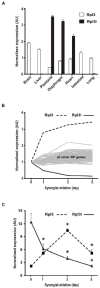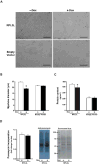Expression of Muscle-Specific Ribosomal Protein L3-Like Impairs Myotube Growth
- PMID: 26684695
- PMCID: PMC4879083
- DOI: 10.1002/jcp.25294
Expression of Muscle-Specific Ribosomal Protein L3-Like Impairs Myotube Growth
Abstract
The ribosome has historically been considered to have no cell-specific function but rather serve in a "housekeeping" capacity. This view is being challenged by evidence showing that heterogeneity in the protein composition of the ribosome can lead to the functional specialization of the ribosome. Expression profiling of different tissues revealed that ribosomal protein large 3-like (Rpl3l) is exclusively expressed in striated muscle. In response to a hypertrophic stimulus, Rpl3l expression in skeletal muscle was significantly decreased by 82% whereas expression of the ubiquitous paralog Rpl3 was significantly increased by ∼fivefold. Based on these findings, we developed the hypothesis that Rpl3l functions as a negative regulator of muscle growth. To test this hypothesis, we used the Tet-On system to express Rpl3l in myoblasts during myotube formation. In support of our hypothesis, RPL3L expression significantly impaired myotube growth as assessed by myotube diameter (-23%) and protein content (-14%). Further analysis showed that the basis of this impairment was caused by a significant decrease in myoblast fusion as the fusion index was significantly lower (-17%) with RPL3L expression. These findings are the first evidence to support the novel concept of ribosome specialization in skeletal muscle and its role in the regulation of skeletal muscle growth. J. Cell. Physiol. 231: 1894-1902, 2016. © 2015 Wiley Periodicals, Inc.
© 2015 Wiley Periodicals, Inc.
Figures




References
-
- Burn TC, Connors TD, Van Raay TJ, Dackowski WR, Millholland JM, Klinger KW, Landes GM. Generation of a transcriptional map for a 700-kb region surrounding the polycystic kidney disease type 1 (PKD1) and tuberous sclerosis type 2 (TSC2) disease genes on human chromosome 16p3.3. Genome Res. 1996;6(6):525–537. - PubMed
-
- Cheng G, Merriam AP, Gong B, Leahy P, Khanna S, Porter JD. Conserved and muscle-group-specific gene expression patterns shape postnatal development of the novel extraocular muscle phenotype. Physiol Genomics. 2004;18(2):184–195. - PubMed
-
- Couzin J. Breakthrough of the year. Small RNAs make big splash. Science. 2002;298(5602):2296–2297. - PubMed
MeSH terms
Substances
Grants and funding
LinkOut - more resources
Full Text Sources
Other Literature Sources
Molecular Biology Databases

